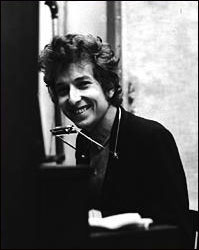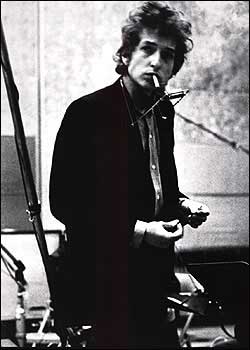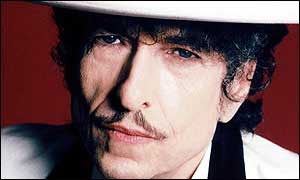| Bob Dylan金曲赏析:Blowing in the Wind |
| http://www.sina.com.cn 2005/02/10 15:10 国际在线 |
[歌手介绍]
Bob Dylan's influence on popular music is incalculable. As a songwriter, he pioneered several different schools of pop songwriting, from confessional singer/songwriter to winding, hallucinatory, stream-of-conscious narratives. As a vocalist, he broke down the notions that in order to perform, a singer had to have a conventionally good voice, thereby redefining the role of vocalist in popular music. As a musician, he sparked several genres of pop music, including electrified folk-rock and country-rock. And that just touches on the tip of his achievements. Dylan's force was evident during his height of popularity in the '60s - the Beatles' shift toward introspective songwriting in the mid-'60s never would have happened without him -- but his influence echoed throughout several subsequent generations. Many of his songs became popular standards, and his best albums were undisputed classics of the rock & roll canon. Dylan's influence throughout folk music was equally powerful, and he marks a pivotal turning point in its 20th-century evolution, signifying when the genre moved away from traditional songs and toward personal songwriting. For a figure of such substantial influence, Dylan came from humble beginnings. Born in Duluth, Minnesota, Bob Dylan was raised in Hibbing, Minnesota from the age of six. As a child he learned how to play guitar and harmonica, forming a rock & roll band called the Golden Chords when he was in high school. Following his graduation in 1959, he began studying art at the University of Minnesota in Minneapolis. While at college, he began performing folk songs at coffeehouses under the name Bob Dylan, taking his last name from the poet Dylan Thomas. Already inspired by Hank Williams and Woody Guthrie, Dylan began listening to blues while at college, and the genre weaved its way into his music. Dylan spent the summer of 1960 in Denver, where he met bluesman Jesse Fuller, the inspiration behind the songwriter's signature harmonica rack and guitar. By the time he returned to Minneapolis in the fall, he had grown substantially as a performer and was determined to become a professional musician. Dylan made his way to New York City in January of 1961, immediately making a substantial impression on the folk community of Greenwich Village. He began visiting his idol Guthrie in the hospital, where he was slowly dying from Huntington's chorea. Dylan also began performing in coffeehouses, and his rough charisma won him a significant following. Five months later, Dylan performed another concert at the venue, which was reviewed positively by Robert Shelton in the New York Times. Columbia A&R man John Hammond sought out Dylan on the strength of the review, and signed the songwriter in the fall of 1961.
Hammond produced Dylan's eponymous debut album which was released in March 1962, a collection of folk and blues standards that boasted only two original songs. Over the course of 1962, Dylan began to write a large batch of original songs, many of which were political protest songs in the vein of his Greenwich contemporaries. These songs were showcased on his second album, The Freewheelin' Bob Dylan. Comprised entirely of original songs, The Freewheelin' Bob Dylan made a huge impact in the US folk community, and many performers began covering songs from the album. Of these, the most significant were Peter, Paul & Mary, who made "Blowin' in the Wind" into a huge pop hit in the summer of 1963 and thereby made Bob Dylan into a recognizable household name. Dylan made his breakthrough to the pop audience in the summer of 1965, when "Like a Rolling Stone" became a number two hit. Driven by a circular organ riff and a steady beat, the six-minute single broke the barrier of the three-minute pop single. Dylan became the subject of innumerable articles, and his lyrics became the subject of literary analyzations across the US and UK. For the remainder of the'90s, Dylan divided his time between live concerts and painting. In 1992, he returned to recording with Good as I Been to You, an acoustic collection of traditional folk songs. It was followed in 1993 by another folk album, World Gone Wrong, which won the Grammy for Best Traditional Folk Album. After the release of World Gone Wrong, Dylan released a greatest-hits album and a live record. Dylan was at least two things for his generation: the freewheeling folk singer - the one who stirred the masses by pointing an accusatory finger at the "masters of war", and the musician who made folk-rock a baroque art. Cynical and cold as the worst of the marginalized, and still the preacher, Dylan has preserved in a corner of his heart the tender, utopian poetry of the generation that made him a myth.
Bob Dylan这个名字让你想到什么?一张忧郁的脸孔、一副沧桑的嗓音、唱着反战歌曲,没错,就是他!Bob Dylan,原名Robert Allen Zimmerman,出生于1941年5月24日的美国明尼苏达州Duluth市。他深受美国现代民谣之父Woody Guthrie的影响,并且在其它方面如腔调、服装、姿态等等也都无不模仿Woody的神情。 Dylan被传奇制作人John Hammond发掘后,便开始连续录制了好几张非常具有政治意识的民谣抗议歌曲,这样的大胆作风旋即冲击了当时的乐坛,当然也立刻获得各方评论界的一致赞扬。甚至在当时整个乐坛已逐渐被类似Beatles的英国歌手占领之时,Bob Dylan却都还能在排行榜上占有一席之地,更加证明了他在当时确实激励了无数的青年开始拿起吉他唱出属于他们世代的民歌。 Dylan写出了大量的优秀作品,他的歌曲成为民权和反战运动的圣歌,像《随风飘逝》Blowin in the Wind 和《大雨将至》A Hard Rain's Gonna Fall这样的抗议歌曲,有像传统的《科里纳,科里纳》Corrina Corrina和以传统为基础的《来自北部乡村的女孩》Cirl from the North Country这样的爱情歌曲,还有像《我将会自由》(I Shall Be Free)这样的滑稽歌曲。迪伦成了民谣摇滚英雄。 Bob Dylan创立了全新的民间摇滚风格,提高了歌词的内涵和品味,改变了摇滚乐原来那种低俗的趣味,他通过深厚、丰富的、完全诗化的抒情化了的歌曲的主题,使听众随着音乐表现出来的原始冲击力感悟到了摇滚乐的那种容易被忽略掉的神韵。他那略显忧郁的、鼻音浓重的粗犷音质,很容易让听众识别。那强劲而粗放的、几乎不加修饰的吉它弹奏,则融入了布鲁斯音乐的精致风韵。 Bob Dylan的歌常常简单得让人吃惊,只有一把吉他加上个口琴。但也正因为这些方面的原因,人们在唱他的歌时觉得更加亲切随意。当你听厌了某些肤浅的歌词、无病呻吟的矫情……你可以回过头来,寻找一些真诚而有个性的、简单而附着灵魂的音乐来听,那么Bob Dylan的音乐应该是你的首选。 |
|
|
|
|
|
|
|
| Annotation |
| 新 闻 查 询 | |
|
关键词 | |
| 热 点 专 题 | ||||
| ||||
|


